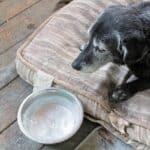During the summer months, there’s nothing better than enjoying some liquid sunshine in your backyard while you barbecue dinner on the grill. Most likely, your dog will want to be by your side while you’re outdoors, not only to enjoy the nice weather with his best friend but also to help you clean the crumbs from the grill.
But summer also brings out insects, and some of these can be, quite literally, pests. Gnats and flies are notorious for coming out in warm, moist temperatures. And while we humans can swat the pesky insects away easily, our four-legged friends are at a disadvantage when it comes to getting the gnats and flies to buzz off.
Why are insects like gnats and flies attracted to dogs?
While they are merely mildly irritating to us, flies and gnats can be downright dangerous to your dog. Flies, in particular, target a dog’s ears, and can bite them so bad they bleed. Flies can then lay eggs in the open wounds and cause your dog to develop an infection in their blood.
Infections are nothing to shake a stick at. They can threaten the health of your dog, particularly if your dog is older and has a weakened immune system. Your dog may not be able to fight off an infection or he may need expensive antibiotics to treat one.
Ways to Keep Gnats and Flies Off Your Dog
Why take the chance of letting insects pester your dog? Here are some effective measures to combat the bug armies that have waged a war against you and your pet.
Method #1: Use Ointment on Your Dog’s Ears
According to Carol McCarthy’s article at PetMD, flies are attracted to your dog’s coat, especially if his fur is unclean or unhealthy. So if you have an older dog, it’s important to either bring your dog indoors during the warmest parts of the day or season. If you do bring him outside, make sure his fur is clean.
If flies are biting your dog’s ears, be sure to keep his ears clean and free of insects. If the flies and pests persist, you might even want to rub some petroleum jelly or Vaseline on the tips of his ears so the flies cannot bite them. Be sure not to apply to areas of your pet that they can lick off.
Depending on how bad the pests are swarming, you might have to reapply often. But if that’s the case, it might be a better idea to let your dog indoors for a while, if possible.
Method #2: Keep Your Yard Free of Waste
Another hint to keep the pests at bay is to rid your yard of the flies’ food source. Flies need to lay their eggs to start another life cycle. Garbage and other waste can attract flies. Be sure to keep garbage cans as empty and clean as possible, because refuse can attract flies and gnats.
As can dog waste. So you’ll want to make sure you keep your yard free from dog poop. The best practice is to clean up after them immediately after they finish their duty.
If you have outside cats, keep an eye out for dead birds or mice your cats might have hunted and left for dead.
Also, be on the lookout for mold and fungi around your yard. Check your vegetable garden for rotting plants, and keep your compost pile covered, if you have one. All of these things can be breeding grounds for flies and gnats. If you keep your yard free from fly food, the bugs will stop bugging you and your dog.
Method #3: Keep Your Dog and His Area Clean
Dogs love to roll in smelly things to try to cover scents up with their own. But as any dog owner knows, that leaves them smelling bad to us, but like roses to gnats and flies.
Be sure to bathe them regularly with a quality shampoo and keep their water and food bowls clean as well. The cleaner their environment, the fewer pests they’ll encounter.
Method #4: Try Homemade Gnat Repellent Recipes
Take a small jar or container and mix in apple cider vinegar with some dawn dish soap. Cover with saran wrap and use a rubber band to secure the plastic top to the container. Poke a dozen or so holes in the top with a toothpick, more or less depending on the size of the opening. Gnats will be attracted to the concoction, and once inside will be trapped until they drown.
Experiment with different recipes. Some say natural fruit juices can be used with the same success. Make sure to keep the jar or container somewhere where the dog cannot reach. And once it gets full, rinse it out and start again.
Method #5: Raid Fruit Fly Traps
These small traps use the same method of the homemade repellent in a jar listed above. But these traps do all the work for you. They are apple-shaped traps that attract and capture gnats and fruit flies, and they come supplied with a food-based attractant that doesn’t contain insecticide.
All you do is fill them with the lure, add some water, and cover. They do the rest. You also get extra lures that should last around 6 months. They can be used both indoors and outdoors. The apple-shaped traps can be reused after being washed with soap and water.
Method #6: Garsum Sticky Traps
No products found.
These sticky traps grab hold of flying pests and don’t let go! They’re dual-sided and can be used indoors or outdoors. They’re natural, safe to use, and they’re waterproof.
They come in packs of 12, 24, or 48 so they are an economical way to control the bugs in an area. You can hang them or stick them into the soil around your yard or in potted plants. Though they are non-toxic, you’ll want to keep them out of the reach of children and your pup(s). They are non-toxic, but they contain a strong adhesive to trap the bugs they attract. They are pet-friendly and super effective.
Method #7: Natural Gnat and Fly Repellent Sprays and Oils
If you’re concerned about toxins in repellents, there’s nothing better than going all-natural. Many essential oils are natural repellents to gnats and flies. As they have been extracted from flowers, trees, and herbs, they smell very strong by themselves.
Here are some of the essential oils known to repel gnats and other insects:
- Tea Tree oil
- Cedarwood
- Cinnamon
- Citronella
- Clove
- Geranium
- Lavender
- Lemon Eucalyptus
- Lemongrass
- Peppermint
- Rosemary
When diluted with water, they can irritate gnats and other bugs so they stay away. Combine these oils with water in a spray bottle and apply to areas where the gnats and flies frequent.
Not only will these natural repellents help fend off unwanted bugs, but they will also give your house and yard a fresh, pretty smell. While these oils are natural and non-toxic, you still should use caution when spraying them around animals. Do not spray them in their face, and a good rule of thumb is if the scent seems too strong to your human nose, it’s too strong for your canine’s nose as well.
Method #8: Flys-Off Insect Repellent for Dogs and Cats
Flys-Off Insect Repellent protects dogs from flies, gnats, as well as from other dangerous insects like mosquitoes, fleas, ticks, and lice. It comes in a pump spray bottle, and can also be sprayed on a dog’s bedding. This is a very effective spray but the bottle is small. It also comes in an ointment form, which is a bit more affordable.
Method #9: Ultrashield Natural Fly Repellent Spray for Dogs
Like Flys-Off, this spray repels flies, mosquitoes, and gnats. It does not repel ticks, fleas, or lice. But it’s an eco-safe formula that uses natural citronella lemongrass and cedar oils. The protection from the spray lasts up to 8 hours. Unlike Flys-Off, it comes in a larger, more economically sized bottle.
Method #10: Wondercide Natural Flea and Tick Yard Garden Spray
This spray treats your whole yard for insects in a natural and safe way to kill mosquitoes, ants, fleas, ticks, roaches, flies, scorpions, chiggers, crickets, chinch bugs, beetles, gnats, and more. It’s safe for cats, dogs, and children. Just add water to the product and spray your backyard and let it do the rest.
It can treat up to 8,000 square feet, and can even be used on gardens. What makes it so effective is the power of cedar oil, which blocks the octopamine receptor in insects and repels them from the area.
It comes in a ready to use spray and also in a more economical concentrate which must be diluted and needs a separate applicator. You should apply it twice within the first 7-10 days, and after that, every 30-45 days, as needed.
Method #11: Wondercide Natural Deet-Free Mosquito and Insect Repellent
Wondercide was mentioned above because of its naturally derived yard spray. Well, they also make a natural, Deet-free insect repellent spray that’s safe for use on pets and kids.
You can get the repellent in spray form or wipes and in a variety of scents.
There are no harsh chemicals here. No artificial colors, dyes, fragrances or pesticides. All ingredients are natural and food-grade.
Final Thoughts
Pests like gnats and flies can be a nuisance in the life of a pet owner and a literal pain for a dog. Depending on the degree of an issue they cause, they can be dealt with in a number of different ways. Prevention is important in keeping them out of your dog’s area, but if they have already infested, sometimes stronger methods are called for.
The methods described here are all safe and they have different degrees of effectiveness, depending on the circumstances. We recommend trying at-home remedies first, to see if they can solve the problem. And if gnat and fly issues continue, try to use some of the products mentioned earlier.
Whatever solves your problem, whether it be vinegar, cedarwood, or sticky traps, your dog will be sure to reward you with sloppy kisses and an overactive wagging tail.
Just don’t forget to throw him some scraps from the grill to celebrate.
Last update on 2024-04-26 at 02:41 / Affiliate links / Images from Amazon Product Advertising API










